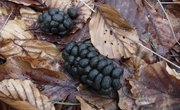Hunters, bird lovers and nature enthusiasts should be able to spot and identify wild turkey droppings. Since the droppings are fairly distinct from the scat of other animals, you need only a basic introduction to correctly identify the droppings.
Look at the size and basic shape. Wild turkey droppings are fairly consistent across different areas and samples. The scat is small and cylinder shaped, with a diameter slightly bigger than a penny. The ends of the droppings are usually blunt and the scat often curls in one direction.
Check for tracks. Wild turkey leave distinct tracks and markings. Turkey tracks are 3- or 4-inches long with 3 toe marks coming off a central circle. Check for marks that are made when the turkeys scratch the ground for food. If you see either wild turkey marks or tracks around a dropping sample you can be fairly sure that the droppings came from a wild turkey.
Note the composition, which is pretty consistent. Often, if the droppings are fresh, you can discern vegetable remains and the parts of insects that the turkey ate. More likely, though, the droppings will display a consistent, dark composition that crumbles easily if it's old and dry.
Understand the difference between gobbler and hen droppings. You generally see two different forms of wild turkey droppings. A gobbler's droppings usually take the shape of a "J" or sometimes a question mark. A hen leaves droppings that more closely resemble a spiral that is all in one pile.
Writer Bio
This article was written by the CareerTrend team, copy edited and fact checked through a multi-point auditing system, in efforts to ensure our readers only receive the best information. To submit your questions or ideas, or to simply learn more about CareerTrend, contact us [here](http://careertrend.com/about-us).


